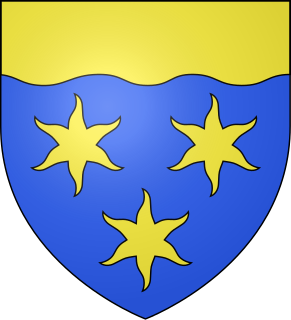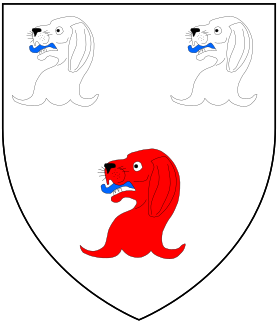
Earl of the County of Cork, usually shortened to Earl of Cork, is a title in the Peerage of Ireland, held in conjunction with the Earldom of Orrery since 1753. It was created in 1620 for the Anglo-Irish politician Richard Boyle, 1st Baron Boyle. He had already been created Lord Boyle, Baron of Youghal, in the County of Cork, in 1616, and was made Viscount of Dungarvan, in the County of Waterford, at the same time he was given the earldom. These titles are also in the Peerage of Ireland.

Viscount Cobham is a title in the Peerage of Great Britain that was created in 1718. Owing to its special remainder, the title has passed through several families. Since 1889, it has been held by members of the Lyttelton family.

Marquess Townshend is a title in the Peerage of Great Britain held by the Townshend family of Raynham Hall in Norfolk. This family descends from Roger Townshend, who in 1617 was created a baronet, of Raynham in the County of Norfolk, in the Baronetage of England. He later represented Orford and Norfolk in the House of Commons. His younger son, the third Baronet, played an important role in the restoration of the monarchy after the Civil War and was also Member of Parliament for Norfolk. In 1661 he was created Baron Townshend, of Lynn Regis in the County of Norfolk, and in 1682 he was further honoured when he was made Viscount Townshend, of Raynham in the County of Norfolk. Both titles were in the Peerage of England.

Earl of Glasgow is a title in the Peerage of Scotland. It was created in 1703 for David Boyle, Lord Boyle.

Earl of Guilford is a title that has been created three times in history. The title was created for the first time in the Peerage of England in 1660 for Elizabeth Boyle. She was a daughter of William Feilding, 1st Earl of Denbigh, and the widow of Lewis Boyle, 1st Viscount Boyle of Kinalmeaky. The title was for life only and became extinct on her death in 1667. The title was created for a second time in the Peerage of England in 1674 for John Maitland, 1st Duke of Lauderdale. For more information on this creation, see the article on him as well as the Earl of Lauderdale.

Earl of Radnor is a title which has been created twice. It was first created in the Peerage of England in 1679 for John Robartes, 2nd Baron Robartes, a notable political figure of the reign of Charles II. He was made Viscount Bodmin at the same time. Robartes was the son of Richard Robartes, who had been created Baronet in July 1621 and Baron Robartes, of Truro, in the Peerage of England in 1626. All three titles became extinct on the death of the fourth Earl in 1757. Anna Maria Hunt, great-niece of the fourth Earl, married the Hon. Charles Bagenal-Agar, youngest son of James Agar, 1st Viscount Clifden of Gowran. Their son Thomas James Agar-Robartes was created Baron Robartes in 1869. For more information on this title, see the Viscount Clifden.

Earl of Halifax is a title that has been created four times in British history. The name of the peerage refers to Halifax, West Yorkshire.

Baron St John of Bletso, in the County of Bedford, is a title in the Peerage of England. It was created in 1582 for Oliver St John.

Earl of Orrery is a title in the Peerage of Ireland that has been united with the earldom of Cork since 1753. It was created in 1660 for the soldier, statesman and dramatist Roger Boyle, 1st Baron Boyle, third but eldest surviving son of Richard Boyle, 1st Earl of Cork. He had already been created Lord Boyle, Baron of Broghill, in the Peerage of Ireland in 1628. He was succeeded by his son, the second Earl. He represented County Cork in the Irish House of Commons and served as Vice-President of Munster. On his death the titles passed to his eldest son, the third Earl. He represented East Grinstead in the English House of Commons. He was succeeded by his younger brother, the fourth Earl. He was a Lieutenant-General in the Army and a prominent diplomat. In 1711 he was created Baron Boyle of Marston, in the County of Somerset, in the Peerage of Great Britain. His son, the fifth Earl, succeeded his third cousin as fifth Earl of Cork in 1753. See the latter title for further history of the peerages.

Earl of Kingston is a title in the Peerage of Ireland. It was created in 1768 for Edward King, 1st Viscount Kingston. The Earl holds the subsidiary titles Baron Kingston, of Rockingham in the County of Roscommon, Viscount Kingston, of Kingsborough in the County of Sligo, Baron Erris, of Boyle in the County of Roscommon, and Viscount Lorton, of Boyle in the County of Roscommon, also in the Peerage of Ireland. He is also a baronet in the Baronetage of Ireland. Between 1821 and 1869 the earls also held the title Baron Kingston, of Mitchelstown in the County of Cork, in the Peerage of the United Kingdom.

Earl of Shannon is a title in the Peerage of Ireland. It was created in 1756 for the prominent Irish politician Henry Boyle, who served as Speaker of the Irish House of Commons and as Chancellor of the Irish Exchequer. The earldom is named after Shannon Park in County Cork.

Earl of Lonsdale is a title that has been created twice in British history, firstly in the Peerage of Great Britain in 1784, and then in the Peerage of the United Kingdom in 1807, both times for members of the Lowther family.

Earl of Burlington is a title that has been created twice, the first time in the Peerage of England in 1664 and the second in the Peerage of the United Kingdom in 1831. Since 1858, Earl of Burlington has been a courtesy title used by the Dukes of Devonshire, traditionally borne by the duke's grandson, who is the eldest son of the duke's eldest son, the Marquess of Hartington.

Earl Granville is a title that has been created twice, once in the Peerage of Great Britain and once in the Peerage of the United Kingdom. It is now held by members of the Leveson-Gower family.

Earl of Dudley, of Dudley Castle in the County of Stafford, is a title that has been created twice in the Peerage of the United Kingdom, both times for members of the Ward family.

Viscount De L'Isle, of Penshurst in the County of Kent, is a title in the Peerage of the United Kingdom. It was created in 1956 for William Sidney, 6th Baron de L'Isle and Dudley, VC, KG, GCMG, GCVO (1909–1991).

Baron Feversham is a title that has been created twice, once in the Peerage of Great Britain and once in the Peerage of the United Kingdom. The first creation, in the Peerage of Great Britain, came in 1747 when Anthony Duncombe, who had earlier represented Salisbury and Downton in the House of Commons, was made Lord Feversham, Baron of Downton, in the County of Wilts. He had previously inherited half of the enormous fortune of his uncle Sir Charles Duncombe. However, Lord Feversham had no sons and the barony became extinct on his death in 1763. The peerage was revived in the Peerage of the United Kingdom in 1826 in favour of his kinsman Charles Duncombe, who was created Baron Feversham, of Duncombe Park in the County of York. He was a former Member of Parliament for Shaftesbury, Aldborough, Heytesbury and Newport. Duncombe was the grandson of Thomas Duncombe, son of John Brown by his wife Ursula Duncombe, aunt of the first Baron of the 1747 creation. Ursula had inherited the other half of her brother Sir Charles Duncombe's fortune. Lord Feversham son, the second Baron, sat as a Conservative Member of Parliament for Yorkshire and the North Riding of Yorkshire.

Baron Dorchester was a title that was created twice in British history, once in the Peerage of Great Britain and once in the Peerage of the United Kingdom. The first creation came in the Peerage of Great Britain on 21 August 1786 when the soldier and administrator Sir Guy Carleton was made Lord Dorchester, Baron of Dorchester, in the County of Oxford. He was succeeded by his grandson, the second Baron. He was the son of the Hon. Christopher Carleton, eldest son of the first Baron. Lord Dorchester died unmarried at an early age and was succeeded by his first cousin, the third Baron. He was the son of the Hon. George Carleton, younger son of the first Baron. He had no sons and was succeeded by his first cousin, the fourth Baron. He was the son of Reverend the Hon. Richard Carleton, younger son of the first Baron. Lord Dorchester was a Colonel in the Coldstream Guards. He was childless and the title became extinct on his death on 13 November 1897.
Charles Boyle, Viscount Dungarvan, 3rd Baron Clifford, FRS, was an English peer and politician. He was a member of a famous Anglo-Irish aristocratic family.

Charles Boyle, 3rd Earl of Cork and 2nd Earl of Burlington, 4th Baron Clifford, PC was a peer, courtier and politician.












